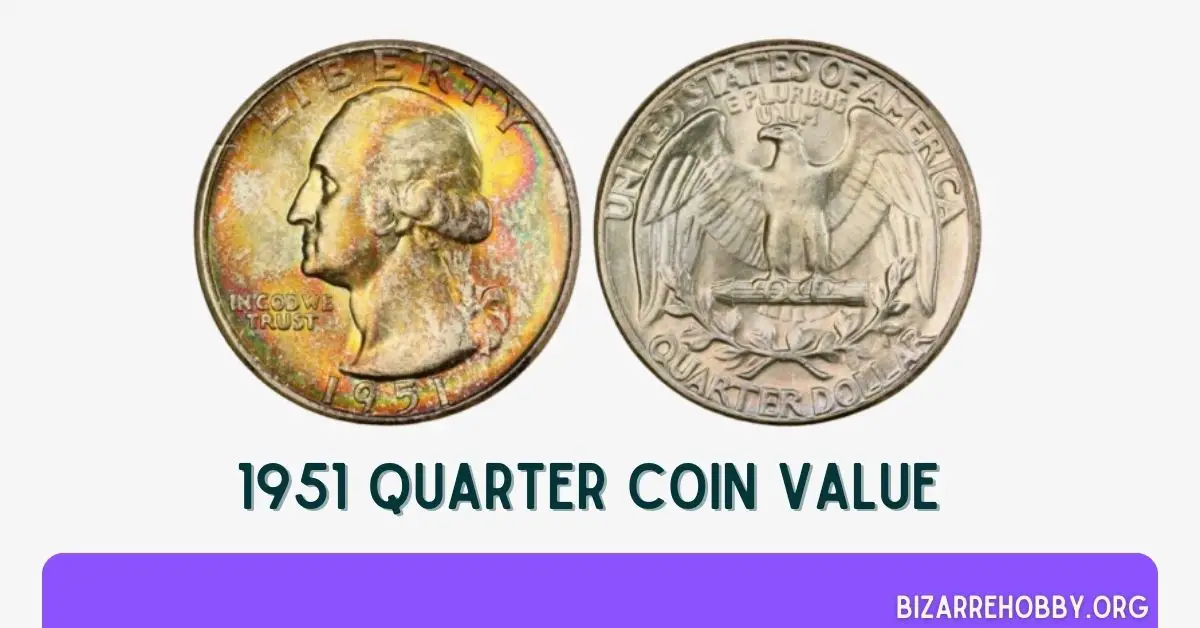Have you recently come across a 1951 Washington quarter or do you own one and wonder about its monetary value? If so, you’re in for an exciting numismatic journey!
A 1951 silver quarter is a remarkable find, not only for its silver content but also for its historical significance and sentimental value. For enthusiasts of American history and admirers of George Washington, collecting these quarters can be both a fulfilling hobby and a potentially profitable venture – if you know what to look for.
In this comprehensive guide, we’ll delve into everything you need to know about the 1951 quarter’s value. We’ll explore its historical context, highlight key features to consider when grading your coin, and provide expert tips for assessing your Washington quarter.
Moreover, we’ll uncover fascinating minting errors that can sometimes elevate the value of these coins to hundreds or even thousands of dollars!
So, is a 1951 quarter worth a significant amount of money? Let’s embark on this numismatic adventure to find out!
Value Chart for 1951 Quarter
| Mint Mark | Good | Fine | Extremely Fine | Uncirculated |
|---|---|---|---|---|
| 1951 No-Mint Mark Quarter Value | $9.43 | $9.43 | $9.43 | $32 |
| 1951-D Quarter Value | $9.42 | $9.42 | $9.42 | $32 |
| 1951-S Quarter Value | $9.42 | $9.42 | $9.42 | $45 |
| 1951 Proof Quarter Value | – | – | – | $56 |
History of 1951 Quarter
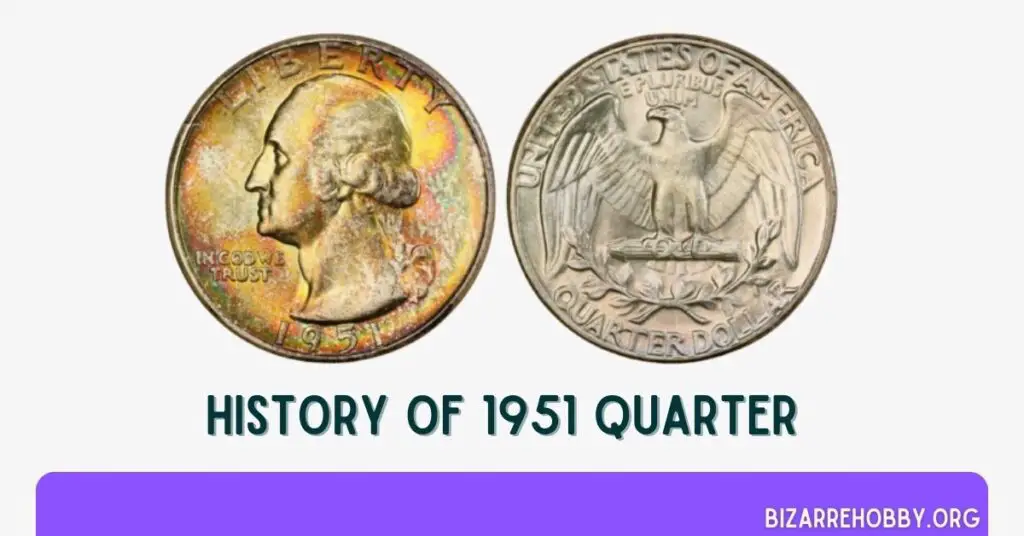
The 1951 quarter is part of the iconic Washington Quarter series, which first graced American pockets in 1932. The story behind this coin’s creation is as intriguing as the coin itself.
In 1930, Congress established the George Washington Bicentennial Committee to oversee preparations for celebrating the 200th anniversary of George Washington’s birth. Part of these celebrations included the launch of a new coin featuring the first president’s likeness.
Initially, the Committee proposed that this new coin should replace the Walking Liberty half-dollar. However, Congress made a different decision, opting instead to replace the Standing Liberty Quarter dollar. This choice would have a lasting impact on American coinage.
The Committee had commissioned sculptor Laura Gardin Fraser to design a commemorative medal and anticipated that her design would be used for the new Washington coin. However, in an unexpected turn of events, the Treasury Department, under the leadership of Andrew Mellon, rejected Fraser’s design.
The Treasury Department asserted its authority in selecting the sculptor for the new Washington coin and launched its own competition. John Flanagan ultimately won this competition and was commissioned to design the new quarter.
After several iterations, production began in July 1932, and by August, the new quarter was circulating throughout the nation. The coin featured a dignified portrait of President George Washington on the obverse and a bold, heraldic eagle on the reverse.
This highly anticipated quarter was struck in silver from its inception until 1965. That year, due to rising silver prices, the Mint altered the composition to copper-nickel, marking the end of an era for silver coinage in everyday circulation.
The Features of the 1951 Quarter
Understanding the features of the 1951 quarter is crucial in determining its value. By carefully examining both the obverse and reverse attributes, you can grade your coin accurately, ensuring you appreciate its true worth.
Obverse Design of 1951 Quarter
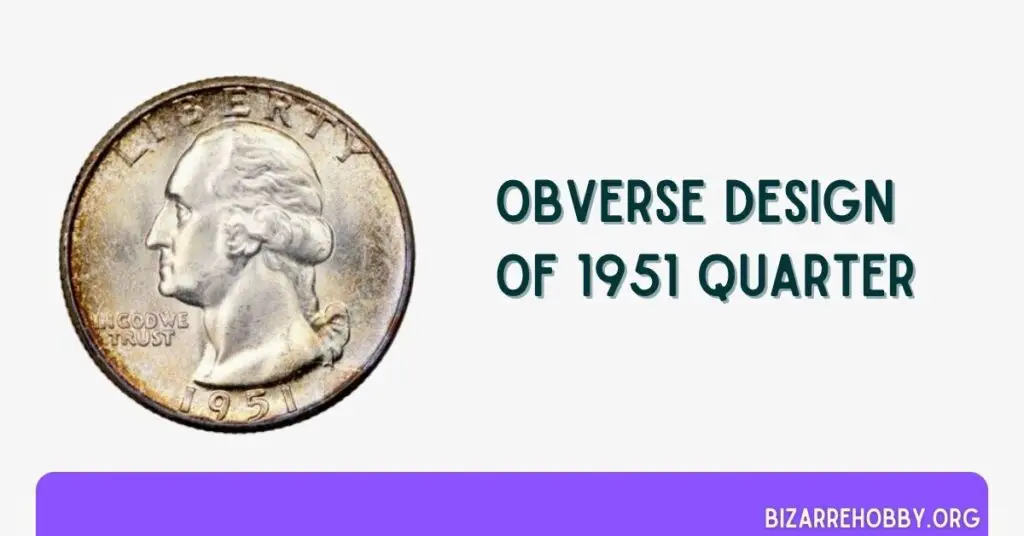
The obverse of the 1951 quarter is dominated by a left-facing portrait of George Washington, occupying most of the coin’s surface. This iconic image, created by John Flanagan, has become one of the most recognizable designs in American coinage.
The word “LIBERTY” is boldly inscribed at the top, following the coin’s circular rim. This prominent placement emphasizes the fundamental American value of freedom.
On the left side of the coin, you’ll find the motto “IN GOD WE TRUST.” This phrase, added to U.S. coins in the mid-19th century, reflects the nation’s deep-rooted spiritual heritage.
At the bottom of the obverse, the year of minting, 1951, is clearly displayed. This date is crucial for collectors and numismatists in determining the coin’s specific historical context and potential value.
Reverse Design of 1951 Quarter
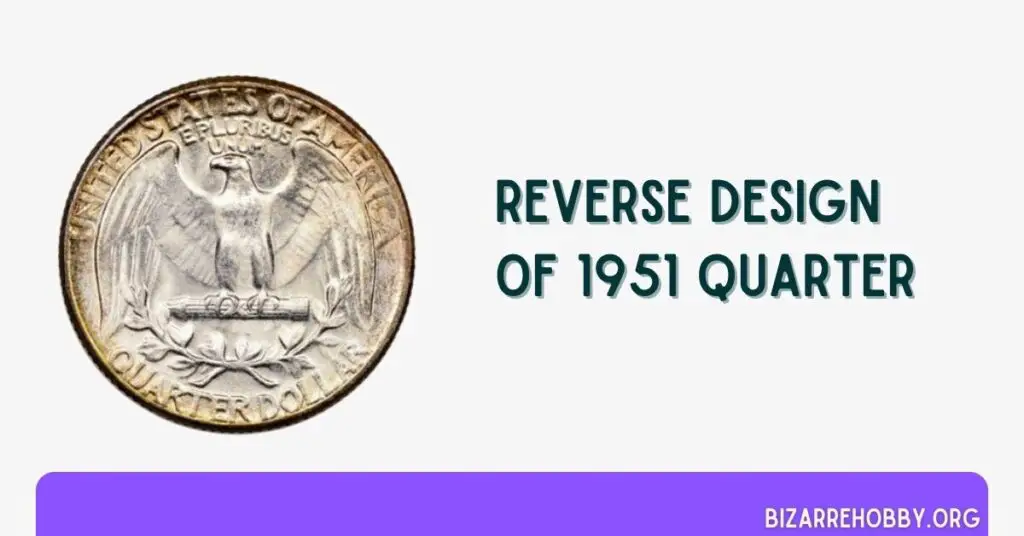
Flipping the coin over reveals an equally impressive design on the reverse. The centerpiece is a majestic bald eagle with its wings spread wide, symbolizing strength and freedom.
The eagle faces left and clutches a bundle of arrows in its talons, representing readiness to defend the nation. Below the eagle, two olive branches are elegantly tied together, symbolizing the desire for peace.
Arching along the top of the coin is “UNITED STATES OF AMERICA,” proudly declaring the coin’s country of origin. Just below this, you’ll find the Latin phrase “E PLURIBUS UNUM,” meaning “Out of many, one” – a testament to the unity of the nation formed from diverse states.
At the base of the reverse, along the inner rim, the coin’s denomination “QUARTER DOLLAR” is clearly stated, affirming its value in the American monetary system.
Technical Specifications of 1951 Quarter
The 1951 quarter is composed of 90% silver and 10% copper, giving it intrinsic value beyond its face value. This reeded coin measures 24.30 millimeters in diameter and weighs 6.30 grams.
In 1951, the Washington quarter was struck at three different mints: Philadelphia, Denver, and San Francisco. Interestingly, only the Denver and San Francisco coins bear mint marks – ‘D’ and ‘S’ respectively. These mint marks can be found on the reverse, just below the olive branch.
The absence of a mint mark indicates that the coin was struck at the Philadelphia mint, which didn’t use a mint mark on quarters until 1980.
1951 Quarter Grading
| Grade Number | Grade |
|---|---|
| 1 | Basal State-1 |
| 2 | Fair |
| 3 | Very Fair |
| 4, 5, 6 | Good |
| 7, 8, 10 | Very Good |
| 12, 15 | Fine |
| 20, 30 | Very Fine |
| 40 | Extremely Fine |
| 50 | About Uncirculated |
| 60 | Mint State |
| 65 | Mint State |
| 70 | Mint State |
Knowing how to grade coins is essential in determining the true value of your 1951 Washington quarter. Whether you’re a collector or an investor, understanding the grading process can help you make informed decisions about buying, selling, or holding onto these historical pieces.
When grading a 1951 quarter, pay close attention to signs of wear on high-contact areas. On the obverse, these include the top of George Washington’s hair, his cheek, and the curl of hair behind his ear. On the reverse, focus on the eagle’s breast feathers and the high points of the wings.
For a quarter to be graded as uncirculated, it should show minimal to no contact marks, flaws, or signs of wear. The presence of any of these imperfections will lower the coin’s grade and, consequently, its value.
Remember, professional grading services use a scale from 1 to 70, with 70 being a perfect, flawless coin. Most circulated coins will fall between 1 and 50, while uncirculated coins typically range from 60 to 70.
For a more detailed guide on grading Washington quarters, we recommend checking out our comprehensive grading guide: “How to Grade Washington Quarters?” This resource will provide you with the necessary tools to accurately assess your coin’s condition and potential value.
1951 Quarter Value Guides
So, what’s the actual worth of a 1951 quarter? The value of a 1951 quarter can vary significantly depending on several factors, including its condition, rarity, and any minting errors. The mint where the coin was produced also plays a crucial role in determining its value.
In 1951, quarters were minted at three different facilities: Philadelphia, Denver, and San Francisco. Each of these mints produced a different number of coins, and the quality of the strike can vary between facilities.
Let’s explore the four varieties of the 1951 quarter in detail:
- 1951 No-Mint Mark Quarter
- 1951-D Quarter
- 1951-S Quarter
- 1951 Proof Quarter
1951 No-Mint Mark Quarter Value

The Philadelphia Mint, which doesn’t use a mint mark, produced an impressive 43,448,102 quarters in 1951. Due to this high mintage, these quarters are relatively common, especially in circulated condition.
However, uncirculated examples are becoming increasingly scarce, with gem-quality pieces graded MS67 and above being extremely rare. When these high-grade coins appear at auctions, they often attract serious collectors with substantial budgets.
Even in circulated condition, these quarters are worth more than their face value due to their silver content. Circulated examples typically range from $4.65 to $9.43.
Uncirculated quarters in lower grades are quite accessible, with an MS65 valued at around $35 and an MS66 at about $80. Gem examples graded MS67 and above are significantly more valuable, with MS67 coins fetching up to $1,300 and MS68 specimens commanding as much as $4,250.
The record for a 1951 no-mint mark quarter was set in 2015 when a coin graded MS67 sold for $4,700 at a Heritage Auctions sale.
1951-D Quarter Value

The Denver Mint also had a substantial output in 1951, producing 35,354,800 quarters. This high mintage means that 1951-D quarters are generally common and affordable for most collectors.
It’s worth noting that Denver-minted quarters from this year often show more contact marks than those from Philadelphia or San Francisco. Consequently, very few examples grade as high as MS67, making those that do particularly valuable.
Circulated 1951-D quarters are valued between $4.65 and $9.42. However, the price increases dramatically for uncirculated examples graded MS67 and above, with MS67 coins valued up to $2,150 and MS68 specimens potentially reaching $14,000.
The most expensive 1951-D Washington quarter on record, graded MS68, was sold by David Lawrence Rare Coins for an astounding $17,750, according to the Professional Coin Grading Service (PCGS).
1951-S Quarter Value
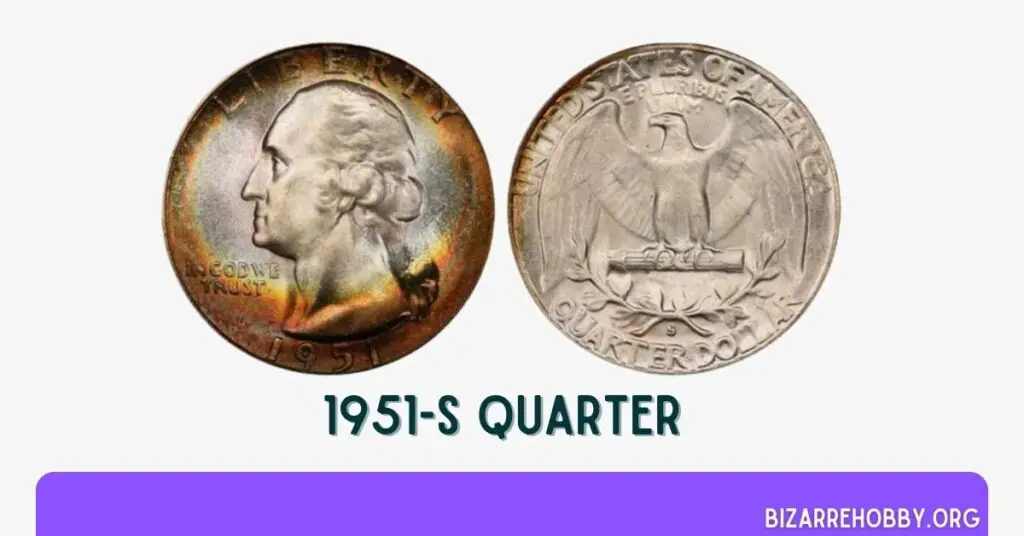
The San Francisco Mint produced the lowest number of regular strike quarters in 1951, with a mintage of 9,048,000. These coins often exhibit a weaker strike due to overused dies, a result of budget cuts following World War II.
Consequently, gem-quality examples graded MS67 are quite rare, although a few have been discovered over the years.
Circulated 1951-S quarters are readily available and valued between $4.65 and $9.42. Uncirculated specimens in lower grades are also relatively affordable, with an MS65 grade coin valued at around $50.
Due to their scarcity, gem-quality coins command higher prices. An MS67 1951-S quarter is valued at approximately $950, while an MS68 can fetch up to $13,000. In 2022, a collector paid an impressive $14,950 for an MS68 graded 1951-S quarter at an online auction.
1951 Proof Quarter Value

In addition to regular strike coins, the Philadelphia Mint produced approximately 57,500 proof silver quarters in 1951. Proof coins are known for their superior strike, featuring frosted details and mirror-like surfaces.
However, the 1951 proof quarters aren’t as brilliant as proof coins struck in later years, often described as having a semi-proof appearance. Cameo and ultra-cameo examples are extremely rare and command significant premiums.
A typical 1951 proof quarter is valued at about $56, but collectors have paid up to $1,800 for specimens graded PF68. The most expensive cameo example on record, graded PF68, sold for $7,050 at a Heritage Auctions sale in 2013.
In conclusion, while most 1951 quarters are worth more than their face value due to their silver content, the truly valuable specimens are those in uncirculated condition or with rare attributes like high grades or proof finishes. Whether you’re a seasoned collector or just starting out, understanding these nuances can help you appreciate the true value of your 1951 quarters.
Rare 1951 Quarter Errors List
Minting errors can sometimes create coins with unique and interesting flaws. These error coins are often highly collectible, fetching values well above their face worth. Below are some notable 1951 quarter error coins that are particularly valuable.
1951 Re-Punched Mint Mark Quarter Error
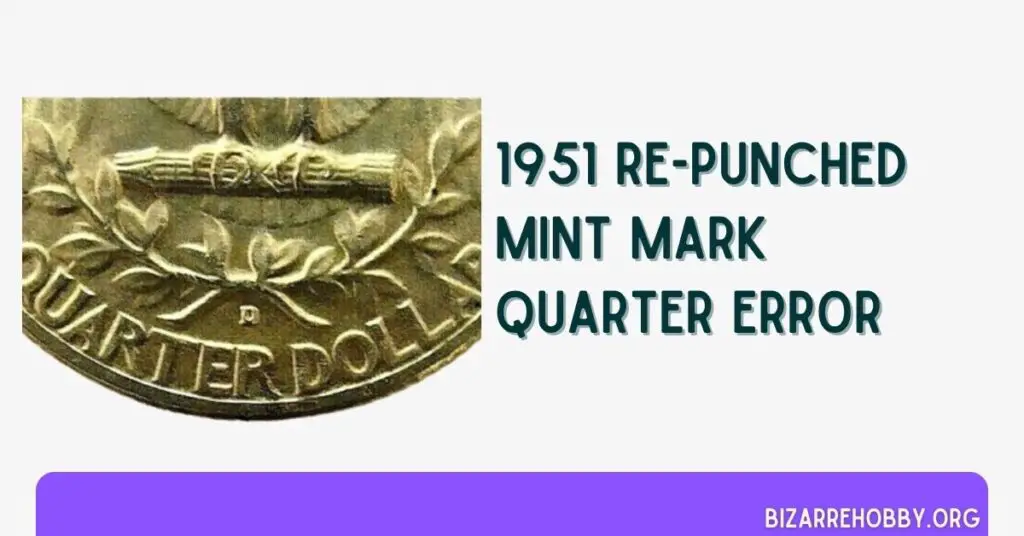
One of the more frequently encountered errors in the 1951 Washington quarters is the re-punched mint mark, especially in coins minted in Denver and San Francisco.
This error happens when the die strikes the mint mark more than once, causing the marks to overlap slightly.
Collectors can pay up to $500 for a well-preserved 1951 quarter featuring this error, with the coin’s condition significantly impacting its value.
1951 Doubled Die Obverse Quarter Error
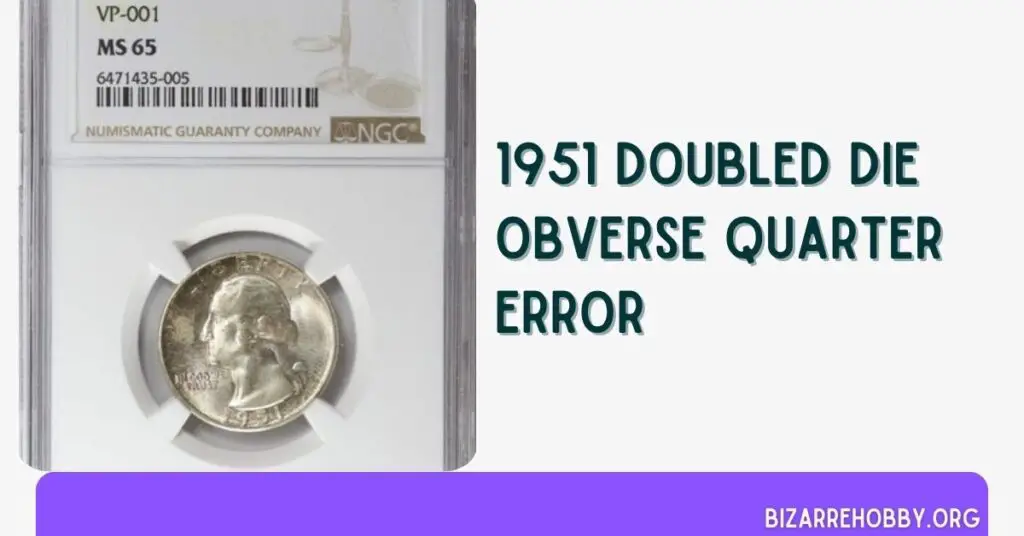
Another common error seen in the 1951 quarters, particularly those struck at the Denver Mint, is the doubled die.
This error occurs when the die imprints the coin multiple times at a slightly different angle each time, resulting in overlapping design elements.
For the 1951 quarter, doubling is usually observed on the obverse side, particularly in the inscriptions LIBERTY, IN GOD WE TRUST, and DOLLAR.
A notable example was sold for an impressive $2,612 at a 2013 Heritage Auctions event.
1951 Clipped Planchet Quarter Error
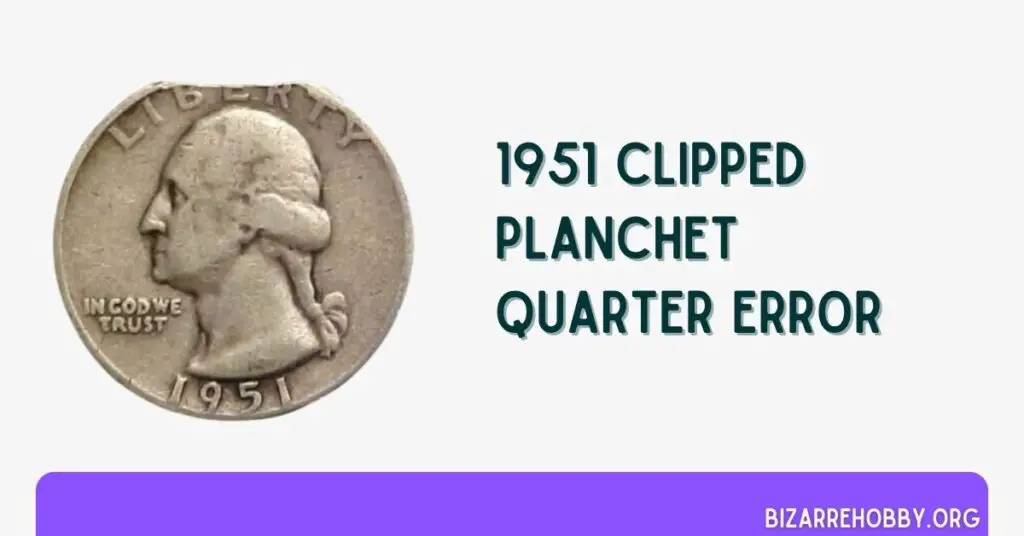
Though not as common, the clipped planchet error can be found in some 1951 quarters. It’s crucial to verify the authenticity of such a coin to ensure it’s a genuine minting error and not an artificially altered piece.
This error arises when a coin’s design is struck on an incomplete planchet, leading to a coin that appears as if a section has been “clipped” off.
Coins with this error can range in value from $200 to $1,300, depending on the size of the clip and the overall condition of the coin.
Where to Sell Your 1951 Quarter?
Now that you’re aware of the potential value of your 1951 quarters, the next step is finding the best places to sell them online. I’ve compiled a list of recommended sites, detailing their advantages and drawbacks. Please read my detailed guide on where to sell coins online.
FAQs on 1951 Quarter
What is the 1951 quarter made of?
The 1951 quarter is made of 90% silver and 10% copper, giving it a distinct composition that adds to its value and appeal among collectors.
How do I know if my 1951 quarter is worth the money?
To determine the value of your 1951 quarter, check for any minting errors, mint marks, and the coin’s overall condition. Coins with errors, such as a doubled die or re-punched mint mark, are typically more valuable. Additionally, having your coin professionally graded by a numismatist can provide a more accurate assessment of its worth.
Are 1951 quarters worth collecting?
Yes, 1951 quarters are definitely worth collecting, especially if they have minting errors or are in excellent condition. Their 90% silver composition adds intrinsic value, and error coins can significantly increase their worth. Collectors find them appealing not only for their historical significance but also for their potential to appreciate in value over time.
Final Thoughts
The 1951 quarter is not only a fascinating piece of American history but also a treasure trove for coin collectors, especially when considering the various errors and mint marks. Whether you come across a “D,” “S,” or a quarter without a mint mark, understanding the unique characteristics and potential value of these coins is essential.
Error coins, in particular, can be worth significantly more than their face value, making them highly sought after by collectors. As you explore the world of 1951 quarters, keep an eye out for these rare errors—you might just discover a hidden gem in your collection.
What’s your favorite find? Let us know in the comments!
